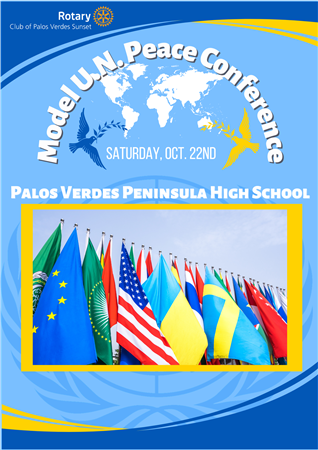Rotary Model UN Peace Conference
|
22 Oct 2022 |
||
 Palos Verdes Sunset Palos Verdes Sunset
|
||
|
The Rotary Club of Palos Verdes Sunset is hosting the District's second peace conference, the Rotary Model UN Peace Conference, on Saturday, October 22nd. The culmination of the $75,450 "reverse" Global Grant Peace Educational Project at Palos Verdes Peninsula High School. Please see what future peacebuilders have learned, witness the Model UN conference on disarmament, listen to the survivors of Hiroshima and other conflicts in Afghanistan and Ukraine, and watch how Peer Mediation works.
| Time | Session | Location: | Speaker (s) |
| 8:30 am - 9:05 am | Welcome | PAC | Jon & Victoria |
| 9:05 am - 9:15 am | Keynote Speaker | PAC | Steven Leeper |
| 9:30 am - 10:30 am | Hiroshima’s Peace Culture & the Meaning of Nuclear Weapons | Library | Speaker #1 - Steven Leeper |
| 10:30 am - 11:30 am | Defenders of Ukraine | Library | Speaker #2 - Ihor Kukhlevsky & Oksana Zayachkivska |
| 11:30 am - 11:45 am | Heiwa Educational Video | Library | |
| 11:45 am - 12:15 pm | Gingko Tree Planting Ceremony | Stage, then planting location | Jon Caplan, Hirko Seki, & Al Muratsuchi |
| 12:15 am - 12:45 pm | Lunch | Covered Lunch Area | |
| 1:00 pm - 2:00 pm | A - Bomb Survivor | Library | Speaker # 3 - Howard Kakita |
| 2:00 pm - 3:00 pm | Life in Afghanistan | Library via Zoom | Speaker #4 - Mr. Abdullah |
8:30 AM Opening Ceremonies
Key Note Speaker: Mr. Kevin Chan from Best Delegate
9:30 AM Steven Leeper: Former Chairman of the Hiroshima Peace Culture Foundation
An Interpreter of the A-bomb survivor testimonies and translated many documents on Hiroshima. He is the co-founder of the PEAC Institute in Hiroshima.
10:30 AM Oksana Zayachkivska & Ihor Kukhlevsky
Ukrainian refugees share insights about their struggles and how music can unite the country's sacrifices.
11:45 AM Hiroshima Survivor Tree planting Ceremony
As a symbol of peace in our community, this ceremony provides a deeper understanding of what happened in Hiroshima and the subsequent sacrifices of the Japanese survivors.
1:00 PM Howard Kakita
He was an American child in Hiroshima on the day the atomic bomb was dropped. Howard Kakita visited his grandparents when the United States destroyed the Japanese city 77 years ago. A fantastic story of survival, inspiration, and dedication.
2:00 PM Mr. Abdullah
Once a Pediatrician in Afghanistan, now a refugee living in Southern California, He had to leave his family behind to immigrate to the U.S.
A Story:
Survive an atomic bomb Jiro Kawatsuma
Rotary Club of Tokyo Yoneyama Yuai, Japan
When I found my sister, only her bones were left. I had been told that she had died in the bombing, so I went to identify her. But when I got to the bomb shelter where she had been hiding with a friend, I only saw two charred bodies. They were unrecognizable. Then I noticed that one had a gold tooth. I knew my sister didn’t have a crown on her teeth, so that’s how I knew which one was hers. I gathered her bones and left her friend there for her own family to claim. My sister was 23. She had been a teacher. Most people think they would like their loved one to live even an hour longer, but with this kind of bomb, I knew it was better to die immediately. I was grateful that she had passed directly. That was the best I could hope for. A B-29 bomber transported the atomic bomb they called “Little Boy” on the morning of 6 August 1945. My mother, father, and sister were in Hiroshima when the bomb hit. I was 18 and a freshman at Hiroshima University. Still, to support the war effort, I had been sent 70 kilometers away to Mihara to supervise a team of high school-age factory workers. We supplied fuel to fighter planes.
I was at work that morning when I discovered a massive bomb had been dropped on Hiroshima. They said the fire was spreading through the city and that catastrophe was unavoidable. At the time, we didn’t know it was an atomic bomb. I got three days off from my superior and rushed to the train station to return to my family, but nobody knew when the trains would resume running. I waited at the station in Mihara the entire day and finally arrived in Hiroshima at about 8 p.m. That delayed train saved me from exposure to the most extreme concentration of radiation. As I walked to my parent's house from the station that night, I saw many dead horses but no human corpses. Seventy-two years later, I learned from a TV program that the streets I had walked down that night were in an area where the first cleanup efforts had taken place. I had been spared from an even more terrifying sight. Our house was destroyed, so I walked to the nearby university campus, where people slept in tents. I found my parents there. My mother was bleeding from her head, but able to talk and otherwise OK. My father had been at his office, a very sturdy concrete building, so he didn’t have many injuries. I stayed in a tent with them that night. The next day, I went to claim my sister’s body.


